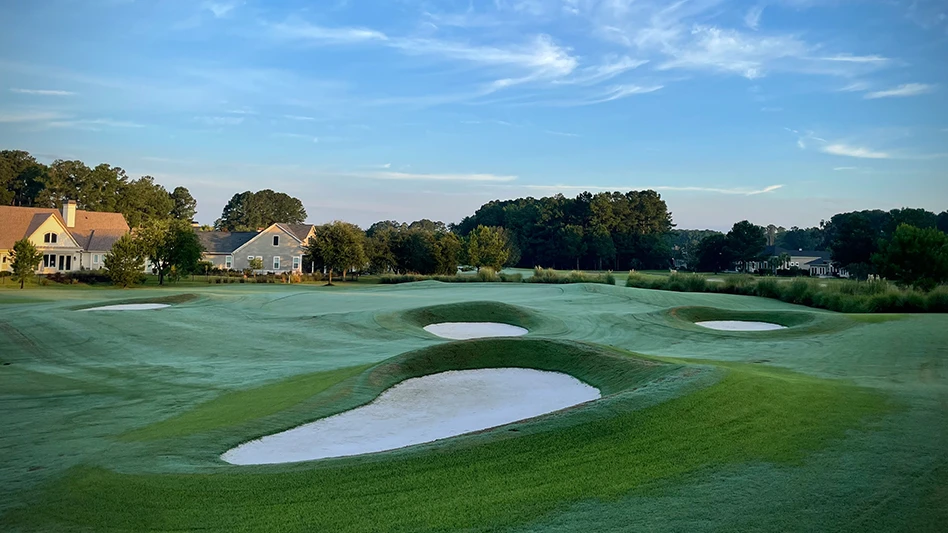

In Bluffton, South Carolina, just 7.6 miles from Hilton Head Island, lies the Hampton Hall Club’s golf course. The Pete Dye design, built in 2004, is an 18-hole private course topping out at 7,503 yards with big waste areas and wide, rolling fairways. On Oct. 1, the club completed a renovation, or as golf course architect Nathan Crace prefers to call it, a restoration of greens, bunkers and irrigation.
In late 2021, Crace flew down to Bluffton with his consulting agronomist Al Osteen and spent three days on the site. The effort originally began as a drainage project. Like most courses over the past couple of years, Hampton Hall has been experiencing an increase in rounds and members.
Frank Zagar, president of Hampton Hall’s board of directors and chair of the golf course restoration committee, says membership increased 100 to 125 members due to the COVID-19 surge and the club was supporting 42,000 rounds per year at its peak.
The course experienced many days with carts on paths as the grounds absorbed water like a sponge, to hear Crace describe it. The soil was muck, clay and sand, and Dye even described it as one of the worst soils he ever built on.
“That was starting to get old quick, especially with all the new members they had and all the rounds they were playing, and it was just really slowing things down,” Crace says. “Their original call was to come over and sort of evaluate the golf course.”
The course’s layout has the cart paths placed away from the fairway. With a lot of members in their 50s, 60s and 70s, allowing them to get off the cart paths was important. In the winter months, controlling traffic was a challenge for superintendent Matt Sapochak, who has been at Hampton Hall since March 2003.
“If you got an inch of rain on Monday, you wouldn’t get off the cart path for two days and you only get off on two (holes) and then after three, four days you get off on a few more (holes),” Sapochak says. “And finally after a week, maybe eight days, you get off 90 percent of the cart paths, but there was one or two like No. 8 and No. 18 you’d be on cart path all the time.”
The first day Crace was on site, the course received around 4 inches of rain. “We got a really good look at their drainage situation,” he says. In addition to drainage, the entire course was evaluated.
“We were looking at the bunkers and we were looking at the greens and tees and everything while we were riding around,” Crace adds. “In our report, we discussed the drainage and what we thought needed to be done, but we also touched on greens and bunkers.”

Crace grew up in southern Indiana and Dye was the first golf course architect he had exposure to and had opportunities to play on his courses. After reviewing the course, Crace says he felt, “There were parts of the golf course to me that didn’t feel like a Pete Dye golf course.”
He then talked to the club and Sapochak about what he noticed. Sapochak mentioned to Crace that at the time the course was built, Dye was going through cancer and chemotherapy treatments. The architect would visit the course between treatments.
Sapochak mentioned to Crace that, “He just wasn’t the old Pete at that point in his career and, in Matt’s words, he just didn't feel like arguing with the contractor,” Crace says. “There were some bunkers that he wanted raised up higher, he didn't feel like he could see the sand, little things here and there.”
Last summer, Crace returned to Hampton Hall. The club discussed — and ultimately decided — to execute the renovation all at once instead of dragging it out over multiple years. Work commenced on April 1, 2023, with Landscapes Unlimited handling the bulk of the work.
Kentucky-based Golf Preservations installed 2-inch micro slit drainage across 35 acres of fairways and around greens. “This new 2-inch micro slit pipe that Golf Preservations installed, what they did was they went in, and they put 4-inch trunk lines tied into all of these basins and then they ran the 2-inch micro slit pipe parallel with the irrigation lines, so from tee to green on 10-foot spacing,” Crace says. “And if they got an area like a particularly problematic catch basin that stayed wet all the time, they’d throw in a couple of extra lines on 5-foot space.”
On top of the drainage, forward tees were added, which has been a theme during recent years. After having spoilages from the trenching, they added palmetto tees for older members, a total of 13, with a majority of them being 25-by-15-foot areas.
Dye told Sapochak that he wished he had added a bunker on the third hole. Now almost 20 years later, the bunker was added. A waste area on the 18th hole was also enhanced.
“The first time I played the golf course, we were standing on 18; it’s a long par 4,” Crace says. “Standing on the tee, there’s a waste area all up the right-hand side, but you can’t see it because there’s sort of a ridge that runs up the right side of the fairway and then it turns, kind of flares out, and there’s a nose on the end of this mound that hides the waste area.
“So, driving down the fairway the first time we were there, popped up over the hill and see this waste area. We took the nose off the end of that mound, and we cut it back maybe 15 feet, so now when you’re standing on the tee, you can see the waste area off the right-hand side.”
Before working on the greens, Crace and Osteen pulled samples and tested them in the lab. The results confirmed what they had suspected. “The top 4 inches just had a lot of organic material in it,” Crace says.
Despite Sapochak having some of the best Tifdwarf greens Crace had ever seen, Sapochak was having more and more issues with the greens. “We cored out 4 inches on every green, put in a new mix, tilled it into the profile, floated it back out and then sprigged it with TifEagle,” Crace says.
The grow-in has been successful, but not easy for Sapochak and his crew. The beginning stages were difficult as a crew member had to hand water the surfaces every 30 to 40 minutes to ensure they stayed wet and nothing dried out.
“It was a pain because you didn't want to drag the hose on the green yet,” Sapochak says. “You had to put shovels around the edges, stick a shovel in the ground and keep your hose off the greens. It was a lot more difficult to handle.”
On top of that, Sapochak had to smooth the greens and cope with the coastal weather. “We had them probably 50 percent grown in, 60 percent grown in, so there was still some gappage that we had like 2 inches of rain in 30 minutes,” he says. “And it just really beat all the sand out from between the plants and really cratered a lot of grass. So basically, you grew your grass down in this crater and once they got 70 to 80 percent covered up, I started topdressing them. And, you know, I really couldn’t start mowing them as quick as I wanted to because they were cratered out so much.”
Along with the restoration of the course, the driving range and chipping green were also improved. “We put target greens out so you can see your ball land much better than it was,” Sapochak says. “And our chipping green … we did a lot of work around that. Filled in a bunker, cleaned up our old bunker and gave the members a lot more area to chip.”
It’s never easy to close a course for a long period of time, but Zagar believes the members, “are going to be more excited about how effective the drainage is and how many fewer days we’ll have being cart-path only.” The golf professional and marketing department kept the members informed with weekly videos during the closure. The project cost $2.9 million.
The collaboration between Crace and Sapochak proved a success. Sapochak says he enjoyed working with Crace because he wasn’t a “my way or the highway type of architect.”
“He would listen to what you had to say, and we would talk about stuff and say, ‘What about this, or what about that?’” Sapochak adds. “I’d say, ‘I’m worried about this,’ and he’d say, ‘We could do this.’ That’s what was good about him. He wasn’t just a, ‘Hey, look, this is the way it is and that is the way it’s going to be,’ which I was really glad.”
Sapochak’s history working with Dye benefited the project. “Having someone not only who had that relationship with the original architect but has been there since construction and literally every day since the golf course opened, you can't put a price on that,” Crace says.
Sapochak lauded Crace’s approach to the project. “He worked really hard to keep it looking like a Pete Dye golf course,” he says. “It doesn’t look like a Nathan Crace course, it looks like a Pete Dye golf course still to this day and I thought he did a great job on doing it. I’d recommend him to anybody who has a Dye course and wants to do some restoration work on it.”
Crace wouldn’t mind if the Hampton Hall project led to more Dye restoration projects. “I had somebody ask me if this makes me the Pete Dye whisperer,” Crace says. “So many people go around specializing in restoring (A.W.) Tillinghast and (Donald) Ross and all of that. I think that would be great. … Like I said, I was a Pete Dye fan as a kid.”

Explore the October 2023 Issue
Check out more from this issue and find your next story to read.
Latest from Golf Course Industry
- From the publisher’s pen: Conscientious of a bigger role
- Bernhard and Company partners with Laguna Golf Phuket
- Terre Blanche showcases environmental stewardship
- VIDEO: Introducing our December issue
- Bernhard and Company introduces Soil Scout
- Nu-Pipe donates to GCSAA Foundation’s Centennial Campaign
- GCSAA enhances golf course BMP tool
- Melrose leadership programs sending 18 to 2026 GCSAA Conference and Trade Show





